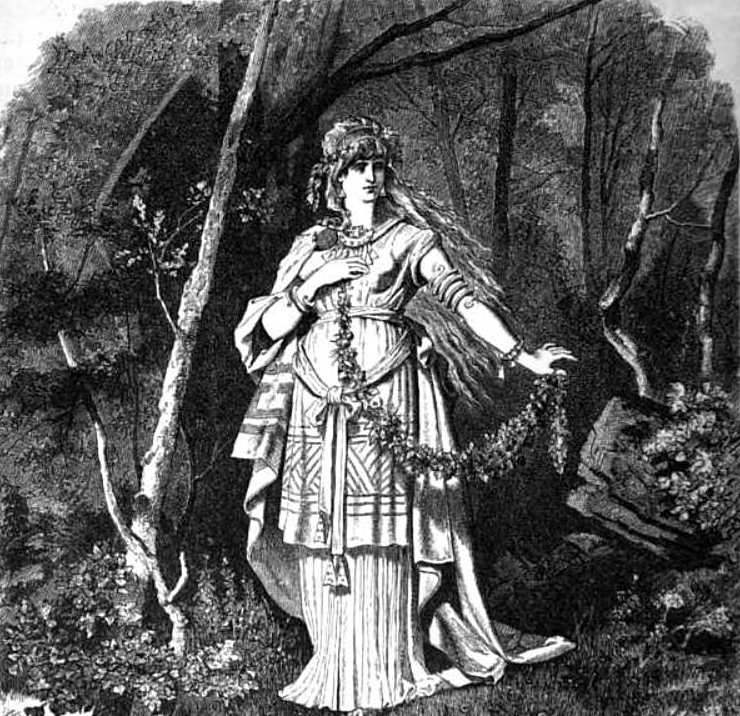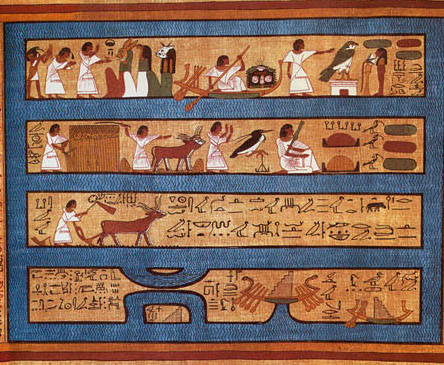|
Neorxnawang
Neorxnawang (also Neorxenawang and Neorxnawong) is an Old English noun used to translate the Christian concept of paradise in Anglo-Saxon literature.Simek (2007:229). Scholars propose that the noun originally derives from Germanic mythology, referring to a "heavenly meadow" or place without toil or worries.Jeep (2001:554). Etymology While the second half of the word, -''wang'', is widely acknowledged to mean 'field' and its cognate ''waggs'' appears for 'paradise' in Gothic, scholars have come to no agreement on the meaning of the first element of the word, though at least a dozen attempts have been made to interpret it by scholars. Scholar Rudolf Simek states that it is possible to consider the term as a Proto-Germanic term for 'Asgard' or 'Other World' due to the noun's unclear meaning, that Christian authors who used it seemed to have a poor understanding of it as well, and that it corresponds with the North Germanic terms ''Iðavöllr'' (possibly 'field of activity' or 'the cont ... [...More Info...] [...Related Items...] OR: [Wikipedia] [Google] [Baidu] |
Fólkvangr
In Norse mythology, Fólkvangr (Old Norse: , "field of the host"Orchard (1997:45). or "people-field" or "army-field"Lindow (2001:118).) is a meadow or field ruled over by the goddess Freyja where half of those that die in combat go upon death, whilst the other half go to the god Odin in Valhalla. Others were also brought to Fólkvangr after their death; ''Egils Saga'', for example, has a world-weary female character declare that she will never taste food again until she dines with Freya. Fólkvangr is attested in the ''Poetic Edda'', compiled in the 13th century from earlier traditional sources, and the ''Prose Edda'', written in the 13th century by Snorri Sturluson. According to the ''Prose Edda'', within Fólkvangr is Freyja's hall Sessrúmnir. Scholarly theories have been proposed about the implications of the location. Attestations In the poem ''Grímnismál'' collected in the ''Poetic Edda'', Odin (disguised, or '' Grímnir'') tells the young Agnar that Freyja allots seat ... [...More Info...] [...Related Items...] OR: [Wikipedia] [Google] [Baidu] |
Aaru
__NOTOC__ In ancient Egyptian mythology, Aaru (; egy, jꜣrw "Reeds, rushes"), known also as '' sḫt-jꜣrw'' or the Field of Reeds, is the heavenly paradise where Osiris rules. It has been described as the '' ka'' (a part of the soul) of the Nile Delta. The ancient Egyptians believed that the soul resides in the heart and so, upon death, the Weighing of the Heart occurred. Each human heart is weighed on a giant scale against an ostrich feather, which represents the concept of Maat. Those souls which balance the scales are allowed to start a long and perilous journey to the Field of Reeds, where they will exist in pleasure for all eternity. Hearts heavy with evil tip and fall into the crocodilian jaws of the demon Ammit. After this "second death", the soul is doomed to restlessness in Duat. The souls who qualify undergo a long journey and face many perils before reaching Aaru. Once they arrive, they enter through a series of gates. The exact number of gates varies accordi ... [...More Info...] [...Related Items...] OR: [Wikipedia] [Google] [Baidu] |
Old English
Old English (, ), or Anglo-Saxon, is the earliest recorded form of the English language, spoken in England and southern and eastern Scotland in the early Middle Ages. It was brought to Great Britain by Anglo-Saxon settlement of Britain, Anglo-Saxon settlers in the mid-5th century, and the first Old English literature, Old English literary works date from the mid-7th century. After the Norman conquest of 1066, English was replaced, for a time, by Anglo-Norman language, Anglo-Norman (a langues d'oïl, relative of French) as the language of the upper classes. This is regarded as marking the end of the Old English era, since during this period the English language was heavily influenced by Anglo-Norman, developing into a phase known now as Middle English in England and Early Scots in Scotland. Old English developed from a set of Anglo-Frisian languages, Anglo-Frisian or Ingvaeonic dialects originally spoken by Germanic peoples, Germanic tribes traditionally known as the Angles, Sa ... [...More Info...] [...Related Items...] OR: [Wikipedia] [Google] [Baidu] |
English Articles
The articles in English are the definite article ''the'' and the indefinite articles '' a'' and ''an''. The definite article is used when the speaker believes that the listener knows the identity of the noun's referent (because it is obvious, because it is common knowledge, or because it was mentioned in the same sentence or an earlier sentence). The indefinite article is used when the speaker believes that the listener does not have to be told the identity of the referent. No article is used in some noun phrases. English grammar requires that, in most cases, a singular, countable noun phrase start with a determiner. For example, ''I have a box'' is OK, but *''I have box'' is not. The most common determiners are the articles ''the'' and ''a''(''n''), which specify the presence or absence of definiteness of the noun. Other possible determiners include words like ''this'', ''my'', ''each'' and ''many''. There are also cases where no determiner is required, as in the sentence ''J ... [...More Info...] [...Related Items...] OR: [Wikipedia] [Google] [Baidu] |
University Of Leeds
, mottoeng = And knowledge will be increased , established = 1831 – Leeds School of Medicine1874 – Yorkshire College of Science1884 - Yorkshire College1887 – affiliated to the federal Victoria University1904 – University of Leeds , type = Public , endowment = £90.5 million , budget = £751.7 million , chancellor = Jane Francis , vice_chancellor = Simone Buitendijk , students = () , undergrad = () , postgrad = () , city = Leeds , province = West Yorkshire , country = England , campus = Urban, suburban , free_label = Newspaper , free = The Gryphon , colours = , website www.leeds.ac.uk, logo = Leeds University logo.svg , logo_size = 250 , administrative_staff = 9,200 , coor = , affiliations = The University of Leeds is a public research university in Leeds, West Yorkshire, England. It was established in 1874 as the Yorkshire College of Science. In 1884 it merged with the Leeds School of Medicine (established 1831) and was renam ... [...More Info...] [...Related Items...] OR: [Wikipedia] [Google] [Baidu] |
Boydell & Brewer
Boydell & Brewer is an academic press based in Woodbridge, Suffolk, England, that specializes in publishing historical and critical works. In addition to British and general history, the company publishes three series devoted to studies, editions, and translations of material related to the Arthurian legend. There are also series that publish studies in medieval German and French literature, Spanish theatre, early English texts, in other subjects. Depending on the subject, its books are assigned to one of several imprints in Woodbridge, Cambridge (UK), or Rochester, New York, location of its principal North American office. Imprints include Boydell & Brewer, D.S. Brewer, Camden House, the Hispanic series Tamesis Books ("Tamesis" is the Latin version of the River Thames, which flows through London), the University of Rochester Press, James Currey, and York Medieval Press. The company was co-founded by historians Richard Barber and Derek Brewer in 1978, merging the two companies B ... [...More Info...] [...Related Items...] OR: [Wikipedia] [Google] [Baidu] |
Routledge
Routledge () is a British multinational publisher. It was founded in 1836 by George Routledge, and specialises in providing academic books, journals and online resources in the fields of the humanities, behavioural science, education, law, and social science. The company publishes approximately 1,800 journals and 5,000 new books each year and their backlist encompasses over 70,000 titles. Routledge is claimed to be the largest global academic publisher within humanities and social sciences. In 1998, Routledge became a subdivision and imprint of its former rival, Taylor & Francis Group (T&F), as a result of a £90-million acquisition deal from Cinven, a venture capital group which had purchased it two years previously for £25 million. Following the merger of Informa and T&F in 2004, Routledge became a publishing unit and major imprint within the Informa "academic publishing" division. Routledge is headquartered in the main T&F office in Milton Park, Abingdon, Oxfordshire and ... [...More Info...] [...Related Items...] OR: [Wikipedia] [Google] [Baidu] |
University Of Helsinki
The University of Helsinki ( fi, Helsingin yliopisto, sv, Helsingfors universitet, abbreviated UH) is a public research university located in Helsinki, Finland since 1829, but founded in the city of Turku (in Swedish ''Åbo'') in 1640 as the Royal Academy of Åbo, at that time part of the Swedish Empire. It is the oldest and largest university in Finland with the widest range of disciplines available. In 2020, around 31,600 students were enrolled in the degree programs of the university spread across 11 faculties and 11 research institutes. As of 1 August 2005, the university complies with the harmonized structure of the Europe-wide Bologna Process and offers bachelor, master, licenciate, and doctoral degrees. Admission to degree programmes is usually determined by entrance examinations, in the case of bachelor's degrees, and by prior degree results, in the case of master and postgraduate degrees. Entrance is particularly selective (circa 15% of the yearly applicants are admi ... [...More Info...] [...Related Items...] OR: [Wikipedia] [Google] [Baidu] |
RMN Newsletter
''RMN Newsletter'' is a peer review, peer-reviewed and open access academic journal published on a bi-annual basis by the University of Helsinki’s Department of Folklore Studies."About". ''RMN Newsletter''. University of Helsinki website. Online/ref> Published in both digital and print editions, ''RMN Newsletter'' covers topics relevant to folkloristics, linguistics, history, archaeology, and philology, especially in the areas of Germanic philology, Germanic studies, Finno-Ugric languages, Finno-Ugric studies, and Baltic studies. The publication places particular emphasis on what the journal refers to as "retrospective methods", a research method that compares material recorded in differing periods.See for example Heide, Eldar. 2010. "Why a Network for Retrospective Methods?". ''RMN Newsletter'', 1, pp. 6-7. University of Helsinki. Online/ref> Since its inception in December 2010, the journal has been edited by Frog, a University of Helsinki docent. ''RMN Newsletter'' originated a ... [...More Info...] [...Related Items...] OR: [Wikipedia] [Google] [Baidu] |
Translated From The Fourth Edition With Notes And Appendix
Translation is the communication of the meaning of a source-language text by means of an equivalent target-language text. The English language draws a terminological distinction (which does not exist in every language) between ''translating'' (a written text) and ''interpreting'' (oral or signed communication between users of different languages); under this distinction, translation can begin only after the appearance of writing within a language community. A translator always risks inadvertently introducing source-language words, grammar, or syntax into the target-language rendering. On the other hand, such "spill-overs" have sometimes imported useful source-language calques and loanwords that have enriched target languages. Translators, including early translators of sacred texts, have helped shape the very languages into which they have translated. Because of the laboriousness of the translation process, since the 1940s efforts have been made, with varying degre ... [...More Info...] [...Related Items...] OR: [Wikipedia] [Google] [Baidu] |





.jpg)
